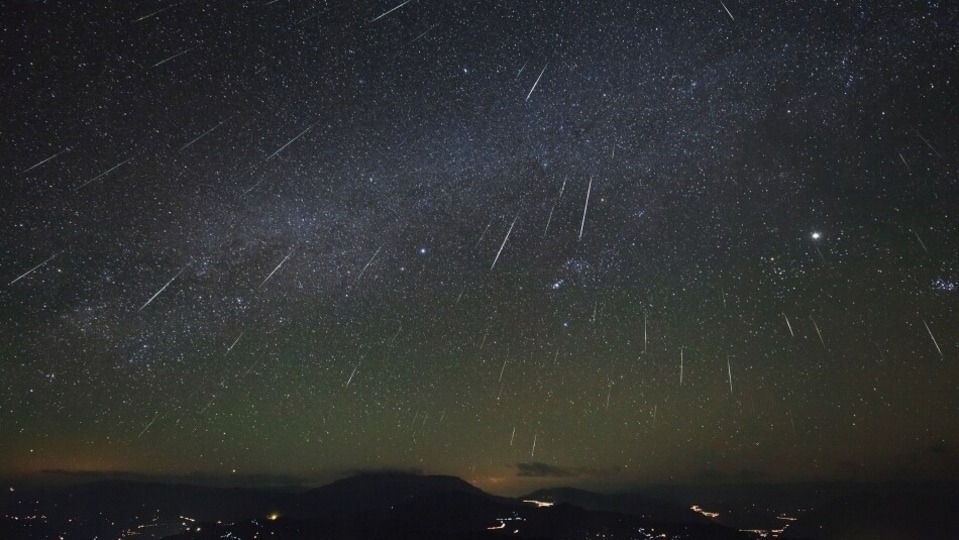
Get ready for some shooting stars — this weekend is the peak of the annual Perseid meteor shower, the beloved astronomical event that sends bright streaks of light streaming across the night sky.
This year’s show should be a good one, “mainly because the moon isn’t going to interfere,” says Michelle Nichols, director of public observing with the Adler Planetarium in Chicago. “We can have different reasons why a meteor shower may be better one year versus the next, and a lot of times it’s the phase of the moon.”
Because the waning crescent moon will be just a little sliver that rises late, the sky will be dark, creating the ideal backdrop for the meteor shower’s celestial fireworks.
The Perseid meteor shower happens annually from around mid-July to late August, and this year’s peak occurs Saturday night into Sunday morning. Weather permitting, Hannikainen said skywatchers could see around 60 meteors per hour — and up to 90 meteors per hour in some of the darkest locations.
“That’s why the Perseids are one of the better meteor showers, because they are so prolific if you’re in a nice dark spot,” she said.
In the Northern Hemisphere, the best way to view the Perseids is to head out in the predawn hours. Hannikainen said meteor showers are best enjoyed under clear and dark skies, away from city lights and other forms of light pollution that can drown out the shooting stars.
Next, skywatchers should plan to get comfortable.
“Grab that lawn chair and settle in,” she said. “It’ll take about 20 minutes to a half hour for your eyes to adapt to the dark. Then you’ll really see the meteors pop out of the sky.”
Under clear conditions, meteors should be visible all over the sky, but the Perseids get their name because they appear to stream from a point in the sky where the constellation of Perseus is located.
“Perseus rises in the northeast in the evening, so that’s where you’ll see most of the meteors appear to come from,” Hannikainen said. “But if you look straight up, you should still see many meteors.”
Faint meteors may appear as flecks that dart rapidly in the night sky, but brighter ones may streak across for several seconds, even sometimes leaving a visible, glowing trail, according to Sky & Telescope.
But don’t be alarmed. It’s perfectly safe! This weekend, August 12–13, is the peak of the Perseid meteor shower, which offers dozens of “shooting stars” per hour. It is one of the best, most reliable meteor showers. And with no bright moon to interfere with this year’s show, it’s a great time to go outside and—at least figuratively—see the sky fall.
Meteor showers are one of the easiest astronomical phenomena to observe. The three most important things required are a dark site as far from city lights as possible, a wide-open sky and patience.
The necessity of darkness should be obvious: most meteors are so faint that you need a decently dark sky to see them. You don’t need to set up camp on a remote mountaintop or anything like that, but being far enough from glowing billboards and streetlights to be able to see, say, magnitude 4.0 stars is a big help.
Meteors can appear anywhere in the sky, so you want to see as much of it as you can. Nearby trees or buildings will block your view toward the horizon, so try to find an open field or even a parking lot (if it’s not surrounded by lights!). The more sky you see, the better.
Patience is crucial, too. Even at its peak, showers of meteors such as the Perseids will only produce perhaps one shooting star per minute, and even half that number is considered a decent show. So don’t expect anything like meteor showers in the movies, where shooting stars streak across the sky every few seconds. But that’s fine! When it takes a minute or two between meteors, each one becomes a bit more special—and surprising. Give it time, and you’ll be oohing and aahing with everyone else.
Also important is when to go out. Given the celestial geometry of this year’s event, the ideal time is after midnight—the later, the better. The best show will occur after about 2 to 3 A.M. EDT, but you’ll still see some meteors even if you go out earlier.
OVERVIEW
OnMyWay Is The #1 Distracted Driving Mobile App In The Nation!
OnMyWay, based in Charleston, SC, The Only Mobile App That Pays its Users Not to Text and Drive.
The #1 cause of death among young adults ages 16-27 is Car Accidents, with the majority related to Distracted Driving.
OnMyWay’s mission is to reverse this epidemic through positive rewards. Users get paid for every mile they do not text and drive and can refer their friends to get compensated for them as well.
The money earned can then be used for Cash Cards, Gift Cards, Travel Deals and Much, Much More….
The company also makes it a point to let users know that OnMyWay does NOT sell users data and only tracks them for purposes of providing a better experience while using the app.
The OnMyWay app is free to download and is currently available on both the App Store for iPhones and Google Play for Android @ OnMyWay; Drive Safe, Get Paid.
Download App Now – https://r.onmyway.com
Sponsors and advertisers can contact the company directly through their website @ www.onmyway.com











